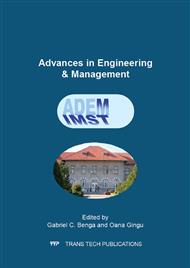[1]
V. L. Berezhnoy, Non-Traditional Process Techniques of Extrusion and Pressing, Int J Adv Manuf Technol (2000) 16: 19–22 2000 Springer-Verlag London Limited.
DOI: 10.1007/pl00013127
Google Scholar
[2]
H. Diarra, V. Mazel, A. Boillon, L. Rehault, V. Busignies, S. Bureau, P. Tchoreloff, Finite Element Method (FEM) modeling of the powder compaction of cosmetic products: Comparison between simulated and experimental results, Powder Technology 224 (2012).
DOI: 10.1016/j.powtec.2012.02.058
Google Scholar
[3]
O. Kostiv, K. Behdinan, S. Hashemi, Finite Element Analysis of Friction-Assisted Powder Compaction Process., (2012) SAE International Journal of Materials and Manufacturing, 5 (2), pp.333-344. 3.
DOI: 10.4271/2012-01-0051
Google Scholar
[4]
A.R. Khoei, Computational Plasticity in Powder Forming Processes, Elsevier Ltd., UK, , ISBN 0080446361, (2005).
Google Scholar
[5]
I.M. Sas-Boca, D. Frunza, HSS Metal Powder Compaction Simulation with Assisted Friction, Global Research Analysis Website: Volume: 2, Issue: 10, Oct 2013 ISSN No 2277 – 8160.
Google Scholar
[6]
S. Shima, Finite Element Simulation of Compaction, Int. J. Powder Metall. 38 (2), (2002), pp.41-47, doi: 10. 1088/1757-899X/10/1/012077.
Google Scholar
[7]
T. Canta, D. Frunza, Friction-assisted pressing of PM components, Conference: International Conference on Advanced Materials Processing Technologies, Madrid, Spain Sep 18-21, 2001 Journal of Materials Processing Technology (2003).
DOI: 10.1016/s0924-0136(03)00475-8
Google Scholar
[8]
I. M Sas-Boca, Research on the use of friction force as an active deformation force in compaction processes, PhD thesis, Technical University of Cluj-Napoca, November (2012).
Google Scholar
[9]
I. M Sas-Boca., D. Frunza, A study of simulation made on powder compaction using friction force as active force, Advanced Composite Materials Engineering - COMAT 2012, Lux Libris; (2012) ISBN 978-973-131-164-7.
Google Scholar
[10]
M. Sas-Boca, Experimental study regarding compressing process with friction force, Advanced Materials Research Vol. 23 (2007), pp.177-180, 2007 Trans Tech Publications, Switzerland, http: /www. scientific. net/AMR. 23. 177.
DOI: 10.4028/www.scientific.net/amr.23.177
Google Scholar
[11]
M. Oyane, S. Shima, T. Tabata, Consideration of Basic Equation s, and their Application, in the Forming of Metal Powders and Porous Metals, Journal of Mechanical Working Technology 1, (1978), 325-341.
DOI: 10.1016/0378-3804(78)90036-0
Google Scholar
[12]
M. Oldenburg, H. -A. Häggblad, B. Wikman, A Friction Model for Iron Powder Pressing Based on a Tribological Approach, Advances in Powder Metallurgy and Particulate Materials, 7, (1996), 329-340.
Google Scholar
[13]
D. -G. Wang, Y. -C. Wu, M. -H. Jiao, X. Ting, J. -W Yu, Research of Favorable Conversion of Friction during Powder Compaction, Material Science Forum, 575-578(1), (2008), 443-448.
DOI: 10.4028/www.scientific.net/msf.575-578.443
Google Scholar
[14]
MSC. Marc, Software Corporation, Volume A: Theory and User Information. " U.S.A. Version (2005).
Google Scholar


